ISSN ONLINE(2278-8875) PRINT (2320-3765)
ISSN ONLINE(2278-8875) PRINT (2320-3765)
Nitin Goel 1 , Shashi yadav 2 , Shilpa3
|
| Related article at Pubmed, Scholar Google |
Visit for more related articles at International Journal of Advanced Research in Electrical, Electronics and Instrumentation Engineering
The induction machine is used as the most common motors in different applications. It is the workhorse of industry. But they require much more complex methods of control, more expensive and higher rated power converters than DC and permanent magnet machines .This paper presents control of a three phase induction motor using single phase inverter with constant volts hertz control (V/F) method and pulse width modulation. Frequency control with flux proportional to V/f and voltage proportional to the speed seems to be the best solution. PWM gives a high quality output voltage. Single phase inverter output gives a better feed to the induction machine without extra components needed on the motor and also produces a higher starting torque and reduced speed pulsation amplitude.
Keywords |
| PWM inverter, volts per hertz, Total Harmonic Distortion |
INTRODUCTION |
| In the present time, in the most of the applications, AC machines are preferable over DC machines due to their simple and most robust construction without any mechanical commutators [1].Induction motors are widely used in many residential, commercial, industrial and utility applications. This is because the motor have low manufacturing cost, wide speed range, high efficiency and robustness [2]. However, the use of induction motors also has its disadvantages, these lie mostly in its difficult controllability, due to its complex mathematical model, its non linear behaviour during saturation effect and the electrical parameter oscillation which depends on the physical influence of the temperature. Induction motor is essentially a constant-speed motor. Its speed of rotation is determined by the synchronous speed. In many industrial applications wide variation in motor speed is required. This can be achieved by varying the stator frequency of the motor thereby varying the synchronous speed. Therefore, Motor control is a significant [3]. There are various control techniques available for the speed control of induction motor, like changing stator poles technique, torque vector control and several others. |
| In this paper we will use a V/f control technique for the control of three phase induction motor. For this we have to kept voltage and frequency ratio constant. There would required to increase the maximum allowed current of the speed control unit thereby making it possible to sell their products to a wider range of customers with different needs for example control of pumps and more powerful fans, so here it is important to minimize the losses created in the machine/motor. AC drives, inverters and adjustable frequency drives all terms that are used to control the speed of AC motor. AC drives receive AC power and convert it to an adjustable frequency, adjustable voltage output for controlling motor operation. The three common inverter types are Current source inverter (CSI), Voltage source inverter(VSI), Pulse width modulation inverter(PWM). |
 |
II. DYNAMIC MODELING OF THREE PHASE INDUCTION MOTOR |
| Let us first consider the stator circuit. The resistance Rs of the stator winding is (for all practical purposes) equal in all three phases. From the law of induction it follows that the part of the stator voltage which is not dissipated in the stator resistance will build up a flux in the stator winding. Hence, with vs s as the stator voltage space vector, the following relation must hold |
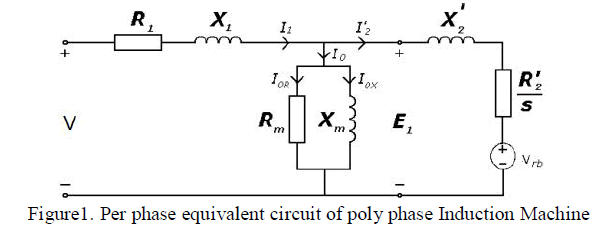 |
| Where: |
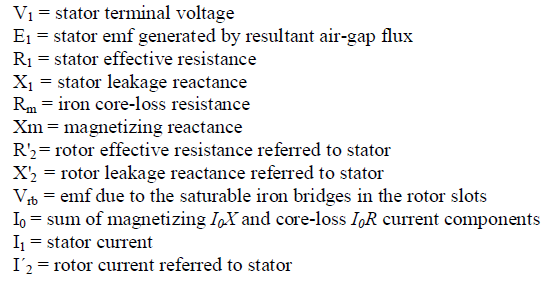 |
| Some of the important steady-state performance characteristics of a poly phase induction motor include the variation of current, speed, and losses as the load-torque requirements change, and the starting and maximum torque. Performance calculations can be made from the equivalent circuit. All calculations can be made on a per-phase basis; Total quantities can be obtained by using an appropriate multiplying factor. |
| The equivalent circuit of (Fig. 1) is usually employed for the analysis. The core losses, most of which occur in the stator, as well as friction, wind age, and stray-load losses are included in efficiency calculations. The power-flow diagram for an induction motor is given in (Fig. 1.1), in which m1 is the number of stator phases, Φ1 is the power-factor angle between V1 and I1, Φ2 is the power-factor angle between E1 and I2´, T is the internal electromagnetic torque developed, ωs is the synchronous angular velocity in mechanical radians per second, and ωm is the actual mechanical rotor speed given by ωs(1 - s). The total power Pg in watts transferred across the air gap from the stator is the difference between the electrical power input Pi and the stator copper loss. Pg is thus the total rotor input power, which is dissipated in the resistance R2´ / s of each phase so that the total power Pg in watts transferred across the air gap from the stator is the difference between the electrical power input Pi and the stator copper loss. Pg is thus the total rotor input power, which is dissipated in the resistance R2´ / s of each phase so that |
 |
| Where T is the internal electromagnetic torque developed by the machine, and ωs is the synchronous angular velocity in mechanical radians per second. Subtracting the total rotor copper loss, which is m1(I2 )ïÿýïÿýR2’= sPg from (Eq. 1.1) for Pg, we get the internal mechanical power developed: |
| To mechanical power and the fraction this much power is absorbed by a resistance of R’2(1-s)/s, which corresponds to the load. From (Eq. 2.2), we can see that, of the total power delivered to the rotor, the fraction (1-s) is converted S is dissipated as rotor copper loss. We can conclude then that an induction motor operating at high slip values will be inefficient. The total rotational losses including the core losses can be subtracted from Pm to obtain the mechanical power output Po that is available in mechanical form at the shaft for useful work |
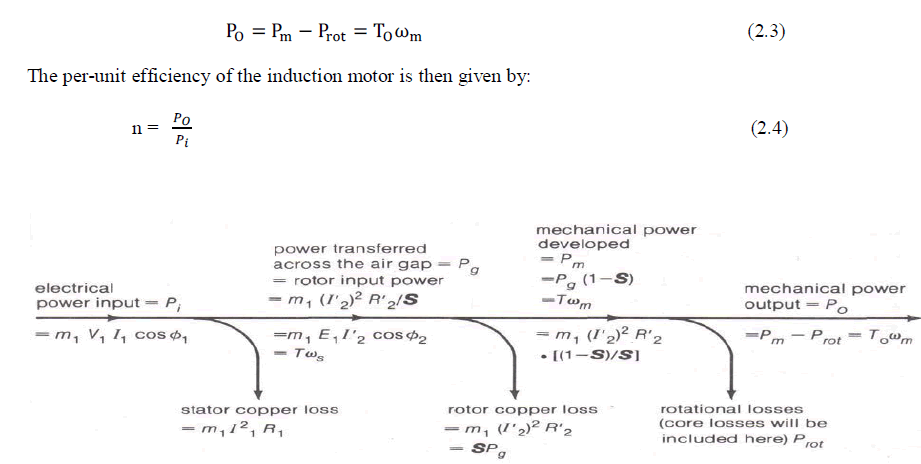 |
III. SPEED CONTROL OF THREE PHASE INDUCTION MOTOR |
| The angular speed in rad / s of an induction AC machine mechanical speed is given by: |
| ωm = (1 − s)ωs |
Studying different control techniques: |
| Voltage control, Frequency control, Vector control, Changing stator poles, Rotor Resistance, Doubly fed motor Although various induction motor control techniques are in practice today, the most popular control technique is by generating variable frequency supply, which has constant voltage to ratio frequency ratio. This technique is popularly known as V/F control [4].In this technique torque developed by the Induction motor is directly proportional to the V/F ratio. If we vary the voltage and frequency, keeping their ratio constant, then the torque produced by induction motor will remain constant for all the speed range. Fig 2.shows the torque-speed characteristics of the induction motor with V/F control. The voltage and frequency reaches the maximum value at the base speed [5].We can drive the induction motor beyond the base speed. But by doing so only frequency varies but not voltage. Hence the ratio of V/F will no longer remain constant. Since the torque developed by the induction motor is directly proportional to the V/F ratio will not remain constant throughout the speed. Power electronic circuits are best suited for this kind of control. |
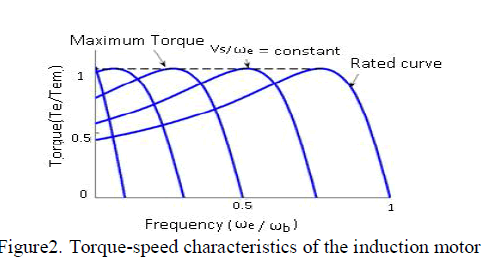 |
IV. CONTROL & SIMULATION RESULTS |
| A. System overview |
| The basic block schematic of three-phase induction motor drive is shown in fig.3. It has 4 pulse discrete PWM Generator, Single phase inverter. In the proposed work the single-phase bridge inverter is designed using IGBT. IGBT switches are used because, they have high switching frequency [2]. Discrete Fourier is used to compute magnitude and phase of fundamentals. In this distorted current waveform convert into equivalent harmonic component. By which, we can find out THD. Output of inverter is feeded to three phase induction motor model for speed control. For creating 3rd phase adding a capacitor branch in series of 2nd phase. |
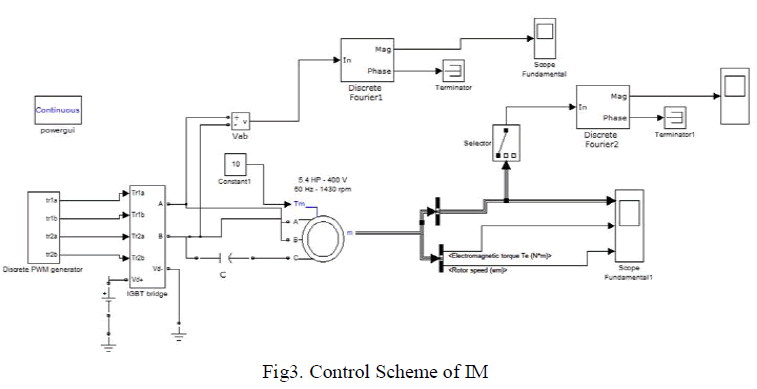 |
| B. Power circuit design |
| Most motors are designed to for sine wave AC supply and the inverter output should be as near to sinusoidal as possible. It is therefore best to choose the control wave with sine shape to give a PWM pattern in which the pulse width is sinusoidal modulated throughout the half cycle. To obtain balanced output voltages in a PWM Generator, the triangular voltage waveform is compared with sinusoidal control voltages .Output of Discrete PWM generator act as gate pulses for IGBT Bridge. |
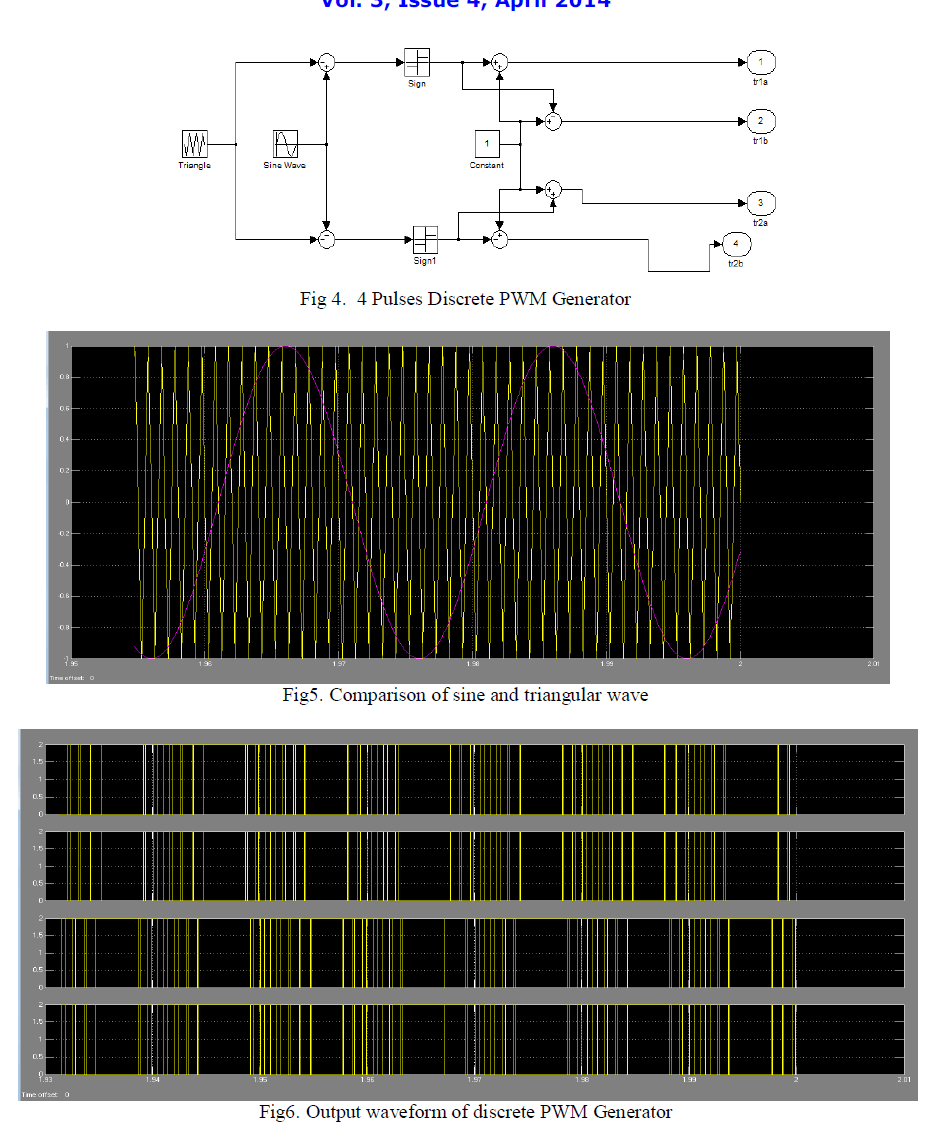 |
| The most frequently used single-phase inverter circuit consists of two legs, one for each phase, as shown in (Fig. 7). The output of each leg, for example VAN (with respect to the negative dc bus), depends only on Vd and the switch status the output voltage is independent of the output load current since one of the two switches in a leg is always on at any instant. Here, ignore the blanking time required in practical circuits by assuming the switches to be ideal. Therefore, the inverter output voltage is independent of the direction of the load current. |
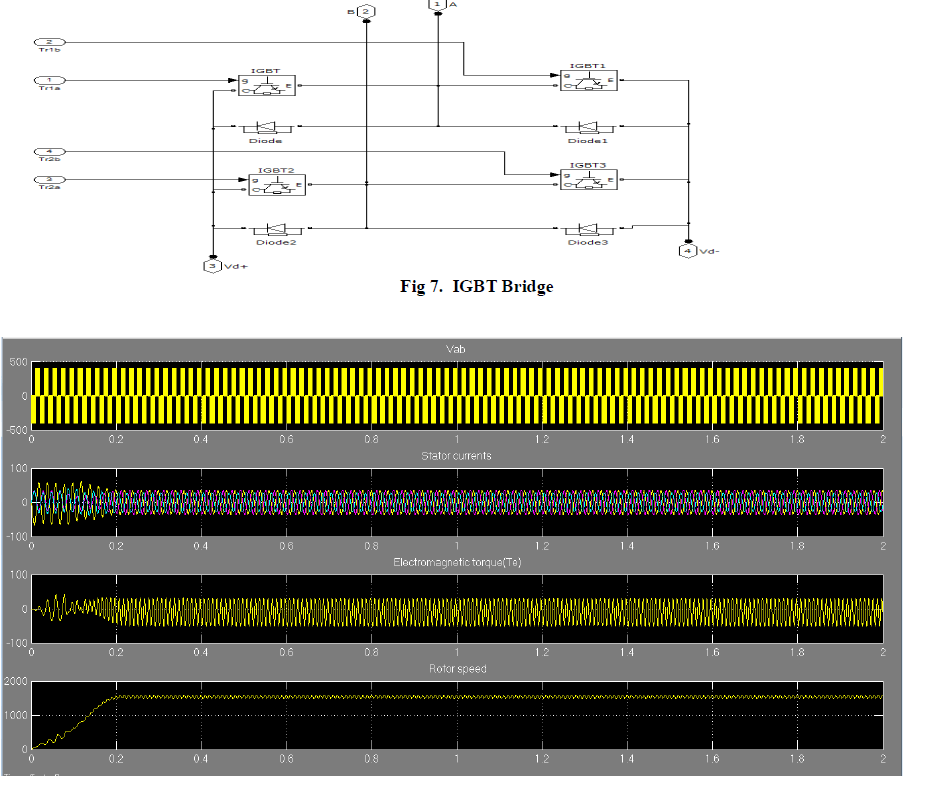 |
| Fig 8.Simulation result of Induction Machine start |
| Simulation results shows higher starting torque produced as compare to other methods of speed control, also PWM inverter reduce speed pulsation |
V.CONCLUSION |
| Three phase induction motor control by using single phase inverter is very economical. Switching from “volt control” to “frequency control (volt / hertz)” method would make it possible to achieve the increase in current supplied to the induction machine, thereby decreasing heat inside the enclosure. The 3-phase output gives a better feed to the induction machine without extra components needed on the motor. It has been observed that 3-phase output from the PWM inverter will reduce speed pulsation and produce a higher starting torque. BY using single phase inverter instead of three phase inverter, reduces the total quantity of IGBT’s .Hence, overall system cost reduces. There will be no need for manual adjustment of each unit, but the technical complicity is going in the wrong direction |
References |
|